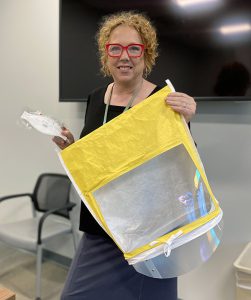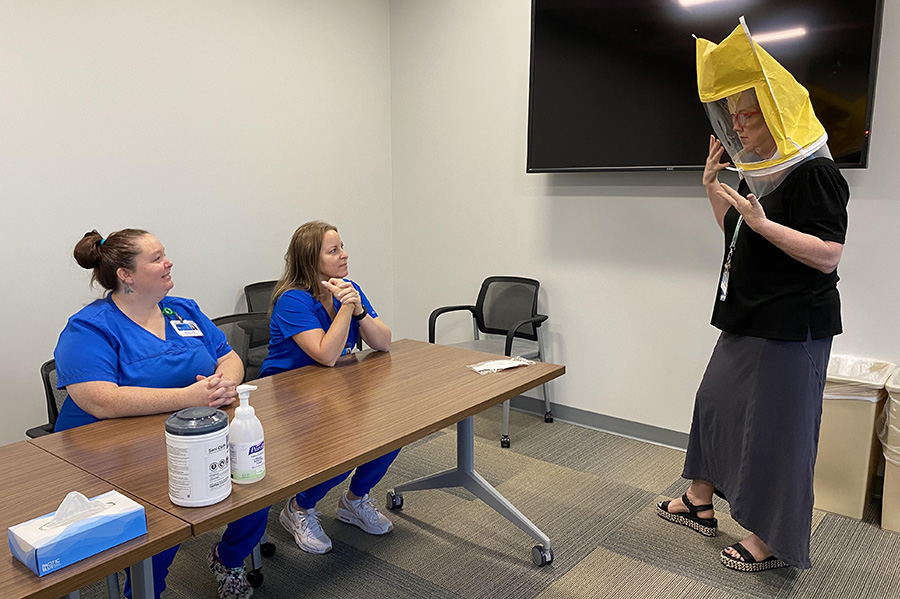See a need and fill it…

OEHN student Shari Crocker
Responding to a significant gap in availability of respiratory protection resources for employers, Shari Crocker, RN, BSN, a student in Occupational and Environmental Health Nursing (OEHN), developed a comprehensive program to help companies be prepared and ensure proper protection for their employees. The program included an explanation of various respirators, detailed training for fit testing, and resources for obtaining proper equipment. This training was presented to local public health officials and county governments with the goal that they may serve as a preparedness resource for local companies.
We asked Shari to share with us about this important program, and how it is addressing a vital need in protecting our workforce.
What led to the idea to develop this program?
I have worked in employee health at Mayo Clinic in Mankato for 15 years. In my time working in this department, I was responsible for preparing for H5N1, H1N1, Ebola, and the COVID-19 pandemic. Not surprisingly, I have become well acquainted with the need for airborne protection, pandemic planning, and respirator fit testing.
When the Covid-19 pandemic hit in the first part of 2020, many friends and acquaintances that worked in medical offices not associated with hospitals (dentists, orthodontics, and the like), reached out to me to ask for assistance with fit testing their staff. I was happy to help and knew this was something I could easily provide. Unfortunately, as I prepared to begin the process of fit testing (and training their staff), I was faced with my first hurdle, who would review the respirator medical evaluation? I knew that I was easily able to do this, but as an RN, I would not be able to address staff that presented with anything but a clean respiratory evaluation. Secondly, the only respirators that these offices could purchase were KN95 respirators which are near impossible to fit and not NIOSH approved. Feeling powerless to help, I reached out to the regional emergency preparedness coalition. I was met with the response that these offices should reach out to their governing body, such as American Dental Association (ADA). These governing bodies often offered little to no direction and were able to offer very limited respirators. My solution, for what seemed like an easy problem, was indeed turning into quite a complex problem and one I was not able to fix. My only option was to provide the contact number for area Occupational Medicine services. The issue remained on the back burner, where I slowly found some fixes. First and foremost, I determined that online resources were available to assist with respiratory medical evaluations. I also grew to understand some of the supply chain issues that left these offices without respirators or access to these supplies.
Tell us more about your project. What were the goals? What was involved? What were the challenges and solutions?
The goal of my project was to provide:
- a framework for local public health offices to improve their readiness for fit testing (I fit tested and trained their staff),
- an educational piece that could be utilized to complete the annual requirements of fit testing, and
- a plan to share with area businesses to better prepare for future pandemics.
Through a partnership with Blue Earth County, I presented a comprehensive plan for companies’ readiness, a thorough explanation of needed respirators and how to avoid counterfeit products and provided a framework for stockpiling. The program offers many links to excellent resources from multiple agencies to ensure all questions are answered. The presentation provided our local public health officials with ties to excellent resources. Blue Earth County officials specifically asked for a step-by-step, easy-to-read procedure for fit testing, which was provided at the end of the presentation.
What are the current and potential future impacts of this program?
Education is critical to ensuring that offices understand the need for access to appropriate PPE and verifying priority from companies should a pandemic develop. As a result of this program, Blue Earth County officials have agreed to assist with helping local businesses obtain needed supplies. This serves as a model for preparedness for future pandemics or other emergency response scenarios. Providing training and education for county officials to serve as a resource for employers in both training and acquisition of PPE can help fill the gaps that were identified in the COVID pandemic.



